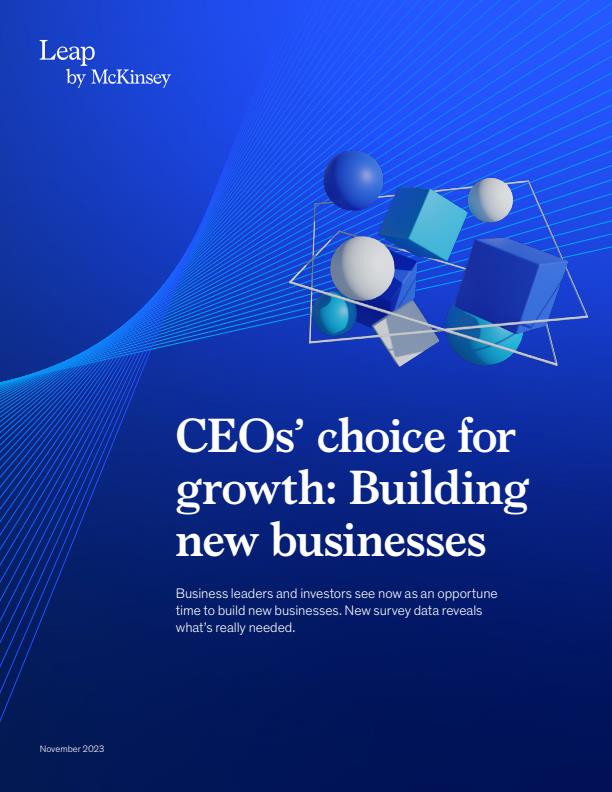Organizations are doubling down on building new businesses, even amid ongoing economic uncertainty. The latest McKinsey Global Survey on new-business building1 finds that a larger share of CEOs than in previous years are making the creation of new revenue streams their top strategic priority.2 Most surveyed business leaders believe the current climate makes this a good time to prioritize those efforts for resilient growth, reflecting the capital advantages of incumbents and anticipated acquisition opportunities. Moreover, as companies grapple with economic uncertainty, CFOs see business building as the most likely strategic action their organization will take in the next 12 months, beating restructuring and capital structure changes.
In our fourth annual report on business building, we explore the types of new businesses that respondents expect in the coming years, with a close look at how advances in generative AI will enhance those efforts. The findings also highlight factors that position companies and new business ventures to succeed.
This year, we also conducted a separate survey of public-equity investors and analysts. These investors also see benefits to companies engaging in business building. Based on this survey, we share practical advice to help business leaders navigate investor perspectives and maximize the value ascribed to their new businesses.
Investments in new businesses are bearing fruit, even during uncertain times
The results of the latest survey show that economic uncertainty hasn’t stopped organizations from investing in new-business building—and, in fact, many business leaders say now is a particularly opportune time to prioritize business building. Survey responses suggest that the rate of business building hasn’t slowed down since last year,3 and 58 percent of surveyed business leaders agree that because of the current economic environment, new-business building has become a greater priority for their organizations in the past year (Exhibit 1). Respondents also point to the fact that their organizations now have a relative advantage compared with start-ups, which are experiencing more difficulty raising capital.

Companies that have already seen success from new-business building are even more likely to double down on it in times of uncertainty: 74 percent of those in the top quartile for the share of organizational revenues from business building say it has become even more of a priority than it was in 2022. Public-equity investors and analysts also see high potential: nearly two-thirds of those surveyed say it would be advantageous for organizations to increase their investment in new-business building over the next year. Furthermore, a majority see business building as an effective method for an organization to increase its valuation.
Indeed, the latest survey results show that new-business building continues to be a top priority for many companies and is a growing priority for CEOs. Twenty-seven percent of surveyed CEOs rank business building as the top priority for their organizations, a larger share than in the two previous surveys. As shown in another recent global survey, CFOs are also prioritizing business building, with 55 percent of CFO respondents expecting it to be their companies’ most likely strategic move in the next year.4
Companies’ focus on new-business building appears to be increasingly reaping benefits. Twenty percent of revenues at respondents’ organizations came from new businesses built within the past five years, up from 12 percent last year.5 Perhaps not surprisingly, responses also suggest that the greater the number of new businesses an organization builds, the greater the share of organizational revenue those new businesses represent, with the greatest increase seen as organizations moved from building one or two new businesses over five years to building three to five (Exhibit 2).

Across industries, companies are prioritizing different types of new businesses
Overall, the types of businesses that business leaders see as the best opportunities for their organizations are broadly in line with last year’s findings.
In advanced industries such as automotive, aerospace, and semiconductors, while most respondents continue to expect their companies to build physical products–based businesses, the share predicting their creation has decreased. There is now significantly increased interest in building data, analytics, and AI-based businesses. These might include end-to-end platforms for predictive maintenance and operational efficiency.
Respondents working in the energy and materials sector1 are also less likely than last year to expect their companies to build physical products–based businesses, as their focus turns even more strongly toward sustainability-based businesses—particularly new energy businesses such as renewables and energy storage. (For more on expectations for sustainability-based businesses, see sidebar “Leaders continue to see opportunities in sustainability-focused business building.”)
Respondents in the healthcare and life science sectors continue to expect to primarily build businesses around physical products. Yet they now show much more interest in everything-as-a-service businesses, compared with last year. Examples can include virtual-health-based platforms, benefit management applications, and medical robotics.





Expectations are high for the role of generative AI
Respondents expect AI capabilities to facilitate new-business building in multiple ways, from enhancing new businesses’ productivity to completely disrupting business models over the coming years. More than half of surveyed business leaders expect that AI capabilities will be necessary for new businesses built in the next five years—double the share for any other specific technology. Even though organizations’ adoption of generative AI, in particular, is still in its early days, nearly half of surveyed business leaders anticipate that these new AI capabilities will accelerate their organizations’ investment in new businesses.6 Investors are even more likely to view generative AI as an accelerant: 75 percent of those surveyed expect generative AI to increase business-building investments.
Despite these high expectations, only respondents at organizations based in North America—where many of the leading commercial large language models have been developed—are much more likely than last year to expect their organizations to build new data- and AI-focused businesses in the coming years. And even last year, their expectations had outpaced most other regions’.
Looking specifically at expected uses of generative AI, we also see meaningful differences by industry, with respondents commonly anticipating that the uses that will underpin their new businesses’ value propositions are the ones most relevant to their value chains (Exhibit 4). In the consumer sector, for example, respondents expect generative AI to help tailor the customer journey, while in travel, logistics, and infrastructure, respondents predict that scenario planning will be the most valuable application.

Three factors of business-building success
When we look at successful new businesses—that is, those that met or exceeded expectations for scale or growth—and the organizations that build them, the results suggest three success factors, from how they make decisions to what kind of support they seek from outside their organizations. (To see one way the leaders of successful new businesses differ from those of other businesses, see sidebar “Diversity in new-business leadership is accelerating, and it matters.”)
Discipline is linked with business-building success
The survey results suggest that the companies launching the greatest number of businesses—and having the most success with doing so—are taking systematic steps during the process.7 Specifically, respondents at the organizations that are best at business building note a handful of mechanisms out of the 12 we tested that seem to underpin their success.8 First, they have an established framework and process for launching new businesses—for example, approaches for testing market hypotheses and criteria for business attractiveness. They also have established partnerships and alliances or a process for putting them in place to support new business building, and they have a systematic method for monitoring and evaluating the new business’s outcomes. These organizations tend to ensure that there is at least one C-suite sponsor to champion business-building efforts, and they hold regular meetings between new businesses’ leaders and the core organization’s senior leaders.
The number of mechanisms an organization has in place to assist with new-business building matters. Respondents who say their organizations have established five or more of these mechanisms to assist with new-business building report a higher volume of new businesses built (nearly twice as many) and a much higher success rate (2.4 times higher) than their peers at organizations with none in place (Exhibit 5).9 In summary, it is about not only having a good idea, a few smart venture leaders, and corporate advantage but also incorporating structure and discipline in the business-building process itself.

Successful builders don’t do it alone
Successful builders10 also know when to seek help from outside their organization. While nine in ten respondents say their organizations have used external partnerships at least to a small extent when scaling their new businesses, respondents from successful builders are nearly twice as likely as others to report using partnerships to a great extent in new-business building. Moreover, 64 percent of all respondents say their organizations’ primary business-building strategies involve acquisitions, suggesting the frequency with which companies are moving outside their boundaries.
The findings also suggest that outside funding is a differentiator. For the second consecutive year, respondents reporting successful new businesses are more likely than others to say those businesses received venture capital or private equity investment while they were being scaled. Coinvestment brings not just money but also additional advice and challenges to new-business leaders’ thinking that can benefit the businesses’ valuation. Sixty-two percent of surveyed investors say the involvement of a recognized venture capital coinvestor in the new business would increase their valuation of that business.
Furthermore, the survey results suggest that accessing marketing capabilities is another key differentiator. Respondents tend to say the capabilities they accessed through external partnerships that were most essential to their organizations’ new businesses were all related to building the business: engineering, R&D, and design. However, respondents reporting success are less likely than others to value the effects of external partners’ R&D work, instead pointing to partners’ marketing capabilities as essential to the new business (Exhibit 6). Other findings also show the importance of new businesses’ access to marketing capabilities in general. Responses suggest that successful new businesses are much more likely than others to have materially used the core organization’s marketing capabilities in their first year and beyond. This finding supports what we have observed at many companies building businesses: building them is often the easiest part. The biggest challenge is how to market and sell the new product or proposition.

Expert builders succeed more often and fail faster
The survey results confirm that experience is the best teacher for new-business building. We learned in previous years that companies with significant experience building businesses are more likely than others to generate a higher ROI. The latest findings show that organizations with the most experience—that is, those that respondents say have built three or more new businesses per year—see higher success rates: they have 2.8 successful businesses for every underperforming one. For companies with less expertise, this ratio drops to 1.6. The most experienced organizations also tend to have the other success factors we identified—such as engaging with external partners—in place.
A closer look at organizations’ success rates shows that experienced business builders have the confidence to shutter businesses quickly when they aren’t succeeding, thereby increasing the success rate of the businesses that are still operating, while other companies do not have this assurance. These expert business builders are 1.4 times as likely as others to close an underperforming business than to continue operating it. Having a formal mechanism for monitoring the performance of the business—which the most experienced builders commonly have—can help organizations determine when to close a business.
Investors spell out how companies can maximize new businesses’ value
This year, we separately surveyed nearly 150 public-equity investors and equity analysts, and their analyses of new-business-building efforts reveal three ways business leaders can think like investors.
First, they can take a portfolio approach to business building. Investors understand the risks and know that success is not guaranteed. On average, their definition of an acceptable success rate for an organization building new businesses—30 percent—acknowledges that more than two out of three new businesses might never become viable, large-scale businesses.
The findings also suggest that investors consider new businesses to be less risky investments than any stage of a start-up, on par with investing in small-cap companies, while appraising these two types of businesses similarly (Exhibit 7). Eight in ten surveyed investors expect a new business built within an organization to be valued at least as much as—if not higher than—it would be if it were an independent company, such as a start-up. Furthermore, two-thirds of surveyed investors say that new-business building is an effective way of boosting an organization’s valuation.

Second, business leaders should be patient rather than expect a speedy path to profitability. Investors are more patient than business leaders may expect—and may, in fact, be in less of a hurry than companies’ leaders to see profits. On average, surveyed investors expect a new business to take nearly four years after the business is publicly announced to reach profitability.
Finally, business leaders can track and report different metrics at different stages in the building process, with a clear strategy for communicating progress to investors. Investors expect evidence of a business’s potential and performance—be it of market demand up front or product–market fit later on—to look different at each stage of the new business life cycle.
In the start-up stage, for instance, investors are concerned about whether the idea is viable and determine whether it’s worth pursuing through metrics such as the number of daily active users.
As the new business grows, investors want to understand its full potential.
As the new business expands and matures, investors are eager to see its growth and profitability.



Responses suggest that a multifaceted strategy for communicating with shareholders can help organizations realize the full value of their new businesses. When asked about the most important actions an organization can take with shareholders, investors say that an organization must clearly communicate the materiality of the new business, be transparent about its expectations for the new business, and provide evidence of the business’s performance. The top way that investors say an organization can show a new business’s materiality is to demonstrate how the business aligns with the core organization’s long-term strategy (Exhibit 9). To ensure transparency about new businesses, responses suggest that organizations can explain their governance models and interactions with the new businesses to shareholders; in previous years, we learned that the likelihood of success of a new business was linked with the degree of separation between the new business and the core organization. As to offering evidence of the new business’s performance, investors most often say companies can show market demand for the business.

The survey findings suggest that investing in new-business building now can better prepare organizations for growth in the years ahead. Successful builders are developing not just a single business but a portfolio of new businesses. And broadly, successful business builders are putting together more diverse teams, building these businesses with discipline, overemphasizing marketing and sales, and involving external partners and investors in the process. They are seeing, as a result, new value creation and significant new revenues.





